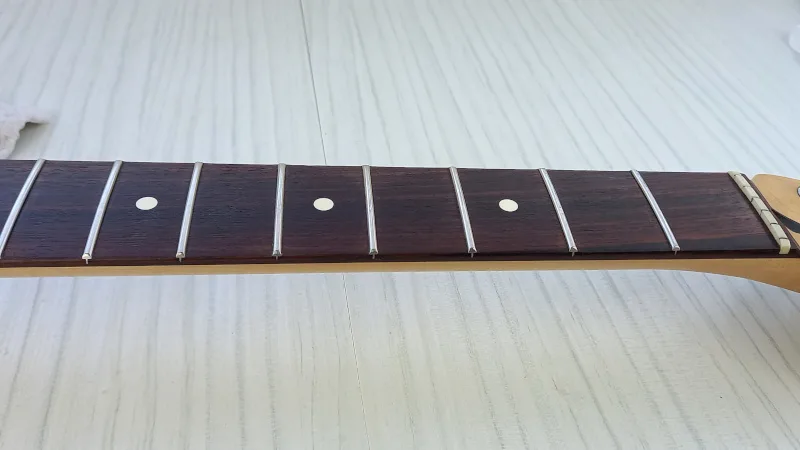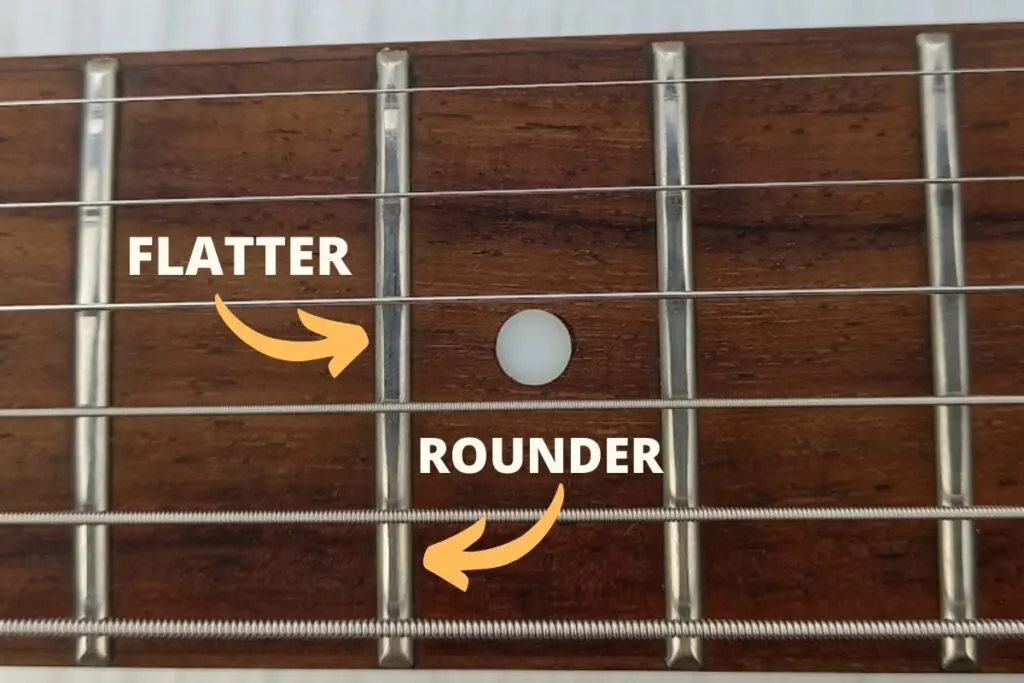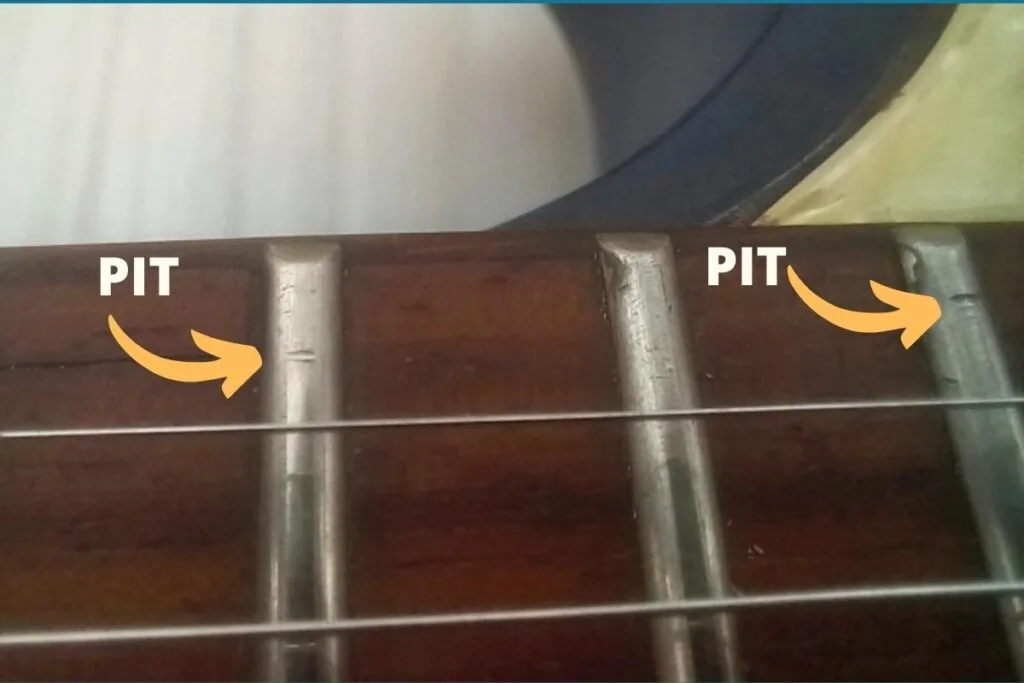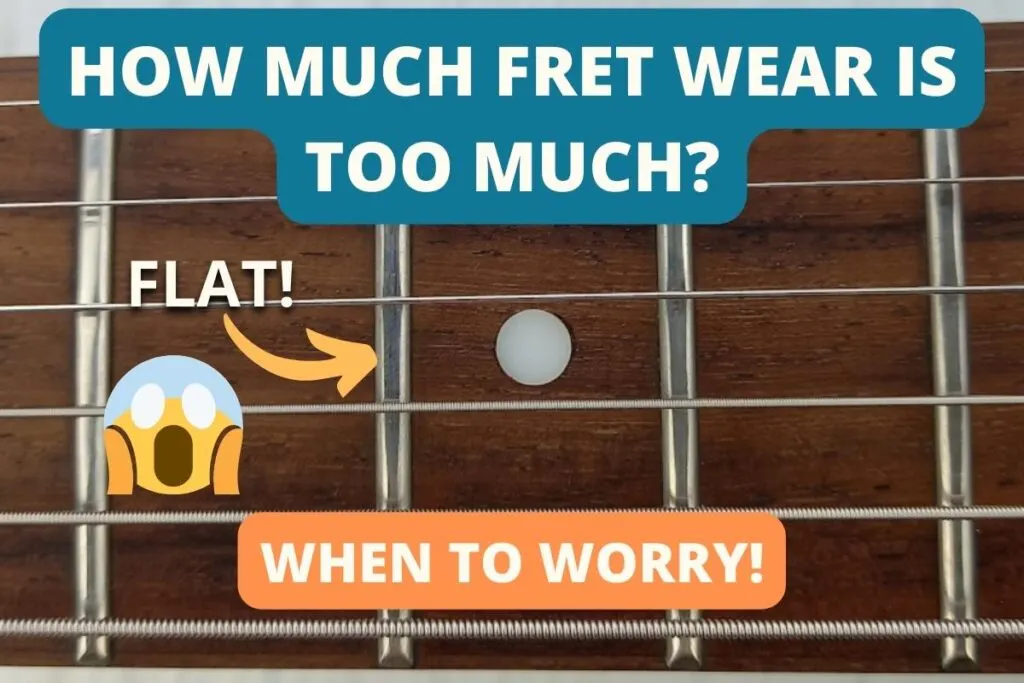As a guitarist, I know that I put my frets through a lot. From light strumming to heavy picking, it all starts to wear down the metal frets that make the guitar notes over time. It’s likely that your guitar will be showing some signs of wear, but how much fret wear is too much?
Fret wear is “too much” when it begins causing problems such as fret buzz, issues with your guitars intonation, or string damage. If you think you have too much fret wear, you should consult a professional luthier to discuss having a fret dressing or a fret replacement.
This guide will make you an expert on fret wear, and will help you to continue getting the best out of your guitar for years to come!
You can use the below links to jump to a section:
What’s causing your frets to wear?
Before we get into whether you should worry about fret wear, it’s important to understand what’s making your frets worn down.
Fret wear happens when the metal of your guitar strings comes into contact with the metal fret wire. The friction and pressure from the guitar strings causes the fret to wear away over time.
It’s a slow process that can take months or even years, but it will eventually happen to your frets!
There’s 3 main factors that can affect the speed of fret wear: fret material, string type, and playing style.
Fret material
The metal that a fret’s made from has a lot to do with how quickly it wears.
The most common metal used to make frets is nickel silver. Despite the name, this material doesn’t actually have any silver in it. It’s actually a mixture of different types of metals, mostly copper, some nickel, and a bit of zinc.

It’s softer structure makes it an easy material to work with and bend into shape, which makes it the top choice for guitar manufacturers. Unfortunately, this softness also means that it’s more prone to wear and damage.
On the other end of spectrum is stainless steel, which is the tough guy of the guitar fret world.
It’s a much stronger metal that can withstand a lot more pressure before showing signs of wear. But, it’s also harder to work with which means that it comes with a larger price tag compared to nickel silver frets.
String type
When your strings come into contact with your frets, there’s a battle between the 2 pieces of metal that causes the weaker one to wear away.
Electric guitar strings come in 2 types: plain and wound. Plain strings are usually the higher strings (G, B, and High E) and wound strings are the lower string (Low E, A, and D).
Generally speaking, most wound strings are nickel plated whereas plain strings are some form of steel. This means that plain strings are more likely to cause wear faster on your frets.
Take a look at your frets and you might just notice that there’s more wear under the higher strings. (There certainly is on mine!)
Playing style
Lastly, but just as importantly, your playing style can have a big impact on how quickly your frets will wear away.
The more friction that’s between your guitar string and fret, the quicker the fret wear. This means that playing styles that apply more pressure like string bends, vibrato, fasting picking and heavy strumming will cause wear faster that other, lighter touch playing styles (but, where’s the fun in that, right?).
As well as this, playing with a capo will drastically increase fret wear!
Capos are the natural enemy of guitar frets. By design, they apply a large amount of pressure between the strings and fret to allow for different tuning, without having to retune your guitar.
Constant use of a capo will speed up the decay of your frets, so I recommend not using them too often.
What does fret wear look like?
There’s 2 main things to look for when you’re looking for fret wear: flattened frets and pitted frets.
Flattened Frets
Take a look at your guitar frets. Do you notice any that seem flatter than the others? This is the beginning stages of fret wear called flattening.
Flattening happens as the metal fret wire becomes squished from the pressure of your guitar strings.
On the lower frets, you’re more likely to see flattening below each individual string, caused by the pressure of fretting chords. They have a distinct “oval” appearance from the top down.
At the higher frets, you’re more likely to see even flattening across the bottom of the fret, where the higher strings are. This is mostly caused by string bends scraping against the metal to push it flat.

Pitted Frets
Pitted frets are a sign of the later stages of fret wear. They’re the result of continued pressure that has worn the metal fret wire away, past being flat, to create a pit or cavity.
Pitting can occur anywhere on the fretboard, usually in the place that you play the most. They make playing guitar harder, as the little gaps can catch your string while bending. They’re are also much more likely to cause fret buzz, intonation problems, and break your strings.

So, how much fret wear is too much?
Now you know the causes of fret wear and what to look for: when should you be worried about fret wear?
The answer is that you should only worry about fret wear if it’s causing problems with your playing, intonation issues, or fret buzz.
All of my guitars have some type of fret wear because I play them a lot, and yours probably will too. But, if you can still play it without it buzzing (assuming you’ve set it up properly), it’s in tune across the fretboard, and there aren’t any large pits that are catching your strings, then there’s nothing to worry about.
Here’s a couple of tests you can do to see if you have too much fret wear.
Check your intonation
Checking your guitar’s intonation (which means how in-tune it is across the whole fretboard) is a good way of identifying any problematic fret wear.
First, make sure that you’ve set you guitar intonation correctly. To do this, follow these steps:
- Use a guitar tuner to make sure your guitar is in tune.
- Play a string on the 12th fret. This should be the same note as when it’s played open.
- If the note is flat (lower than where it’s supposed to be) then loosen the saddle screw.
- If the note is sharp (higher than it’s meant to be) then tighten the saddle screw.
- Do this for each string until all the 12th fret notes are the same pitch as their open string.
Now, play different notes across the neck to see whether they show as the pitch they’re meant to be. If they don’t, then your fret wear may be causing a problem.
Listen for buzz
If a fret has severe wear, then it will cause buzzing. This is because the fret is lower than it’s supposed to be, which causes the string to catch against higher frets.
I wrote a guide on how to set your guitar up to remove fret buzz. I recommend following that guide (which you can find here) to set your guitar up.
Once you’ve done this, try playing your guitar and seeing whether you still have any fret buzz. If you do, then your worn frets are likely to be the cause!
See if it affects your playing
If you’re worried about a pit that’s formed, try playing on it! Put your guitar amp on a clean setting and play some chords and single notes on it, as well as some string bends over it.
If it doesn’t get in the way of your playing, then great! If it’s catching your strings, or causing any buzz like above, then it’s probably time to get it looked at!
How do you fix fret wear?
As I’ve said, fret wear is inevitable. So, luckily, there’s a few different services that can get your frets looking good as new!
I always recommend taking your guitar to a professional luthier for any fret work. While you can buy the tools online, fret work is any easy thing to get wrong, and can end up costing you a lot more money to fix!
That being said, there’s 2 ways a luthier can fix you frets: a fret dressing or a fret replacement.
Fret dressing
A fret dressing is where all the frets are filed down to the same height, using a fret file. This brings all the frets down to the level of the lowest, worn fret.
The filed frets are then “re-crowned”, meaning that they’re filed again to give them a rounded top.
I called 4 local luthiers and I was quoted between £40 and £95 (that’s about $55-$125) for a fret dressing.
This process works best for light fret wear as the more severe the fret wear is, the more the luthier will have to file down. And, there’s only so much that they can file a fret down before it’s unusable!
Larger fret sizes will be able to handle more fret dresses than small frets.
If a fret is already too low, or the wear is too severe, then you’ll need a fret replacement.
Fret replacement
A fret replacement is, as the name suggests, where the worn out fret wire is removed and replaced with new fret wire.
As I said earlier, some fret wire is easier to work with than others. While stainless steel makes a great choice for a fret, it’s also difficult to shape which makes it more expensive as it takes more time.
Luckily, most guitars have nickel silver frets, which will cost you less!
I got 4 quotes between £15 and £25 per fret (about $25 to $32) for a fret replacement.
This is a great option if you have one fret that’s really worn out, as it means that your other frets don’t have to get filed down, but it can quickly add up if you have a few damaged frets.
Final thoughts
Congratulations, you’re now an expert on fret wear! At least, you now know what causes fret wear, how to spot it, how to test for it, and how to get it fixed.
At the end of the day, fret wear is going to happen to all of us guitarists. It’s just the nature of how guitars are made. The good news is that it’s perfectly fixable and, once done, it’ll give your guitar a new lease on life that will keep it rocking for years to come!

Related Questions
Is fret wear bad?
Fret wear is bad for your guitar, as it will affect your ability to play the more severe it gets. Frets that have greater wear are more likely to cause fret buzz, intonation problems, and catch or damage strings.
Most guitars will have some form of light fret wear. It only becomes a problem when it begins causing any of the above issues.
How long do guitar frets last?
The life span of a guitar fret is determined by its material and your playing style. Strong materials such as stainless steel will last much longer than nickel silver. Likewise, lighter playing styles will cause much less wear than heavier playing styles.
Unfortunately, there’s no one answer to this question.
From a personal perspective, my oldest guitar (which has nickel silver frets) is showing signs of fret wear from over 10 years of moderate playing. This is only just starting to affect the intonation, so it will need to go for a fret dressing soon.

Conor is a music producer, multi-instrumentalist, and all-round enthusiast from the UK with over 15 years of experience. He’s the founder and sole-content creator for the roundtable audio blog and YouTube channel.
